Kotlin 学习手记——协程进阶,嵌入式 android 开发教程
val producer = GlobalScope.launch {
for (i in 0..3) {
log("sending", i)
channel.send(i)
log("sent", i)
}
channel.close()
}
//消费者 收
val consumer = GlobalScope.launch {
while (!channel.isClosedForReceive) {
log("receiving")
val value = channel.receiveOrNull()
log("received", value)
}
}
producer.join()
consumer.join()
}
Channel(Channel.RENDEZVOUS ) 的方式是发一个收一个,边发边收,如果没有接受的,发送者会挂起等待,输出如下:
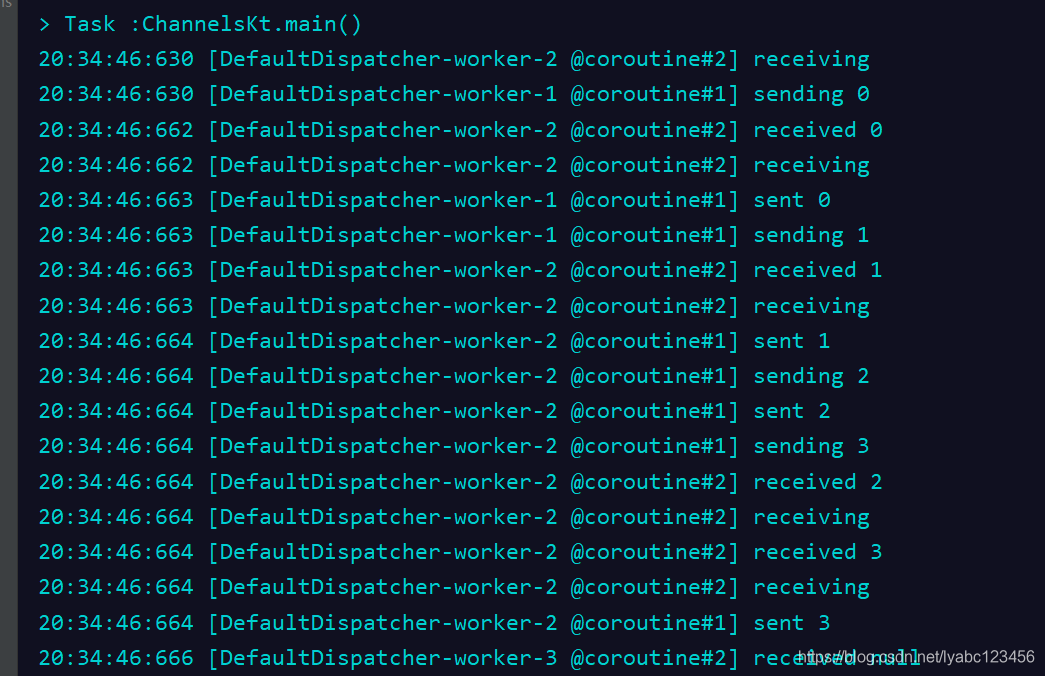
Channel(Channel.UNLIMITED ) 的方式是全部发送完毕,才会接收到,先发后收,发送者发送完就返回了,不管有没有接受者,输出如下:
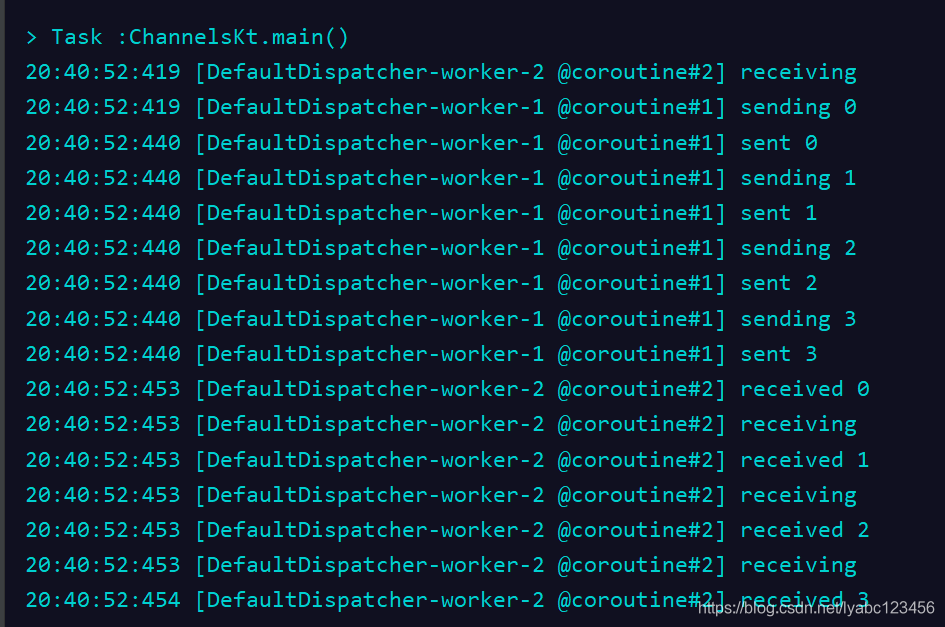
Channel(Channel.CONFLATED ) 的方式是不管发了多少个,只能收到最后一个,也是发送完就返回了,不管有没有接受者,输出如下:
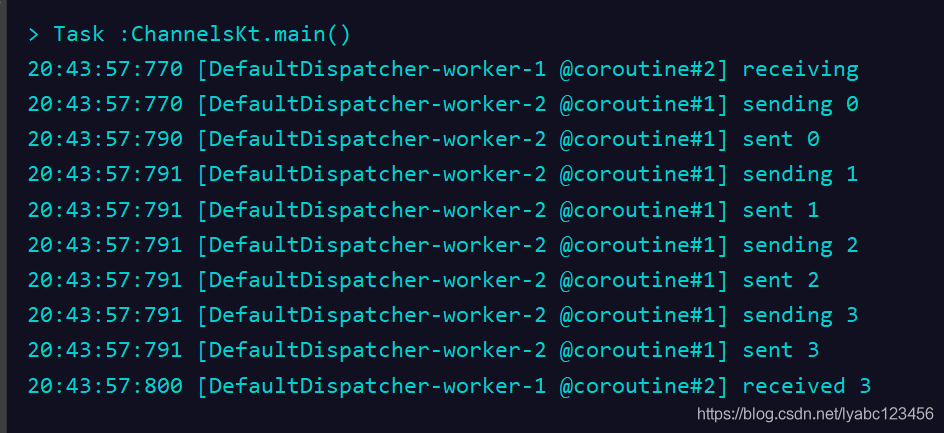
Channel(Channel.BUFFERED ) 的方式也是发送者发送完就返回了,不管有没有接受者,可以指定 buffer 大小,输出如下:
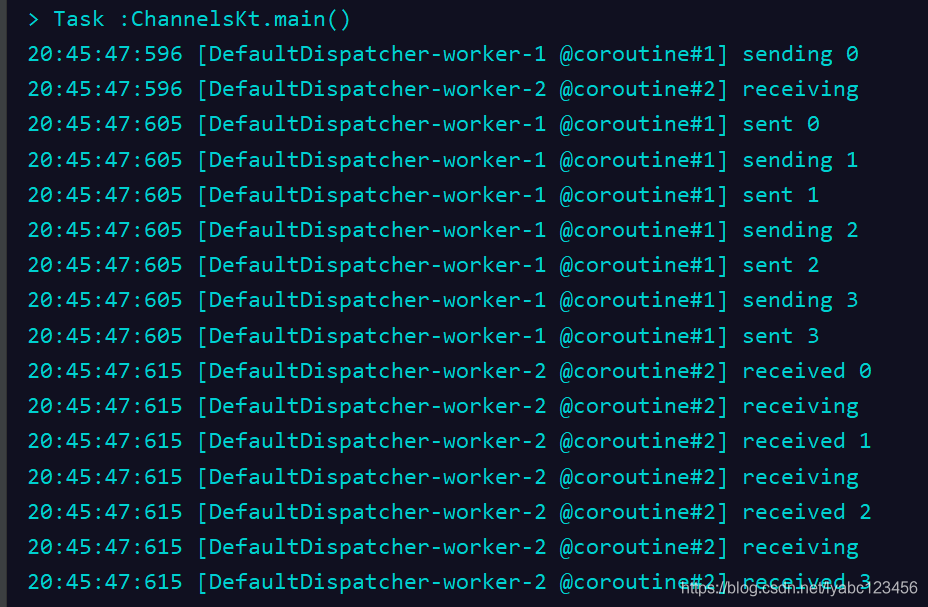
Channel(1) 的方式指定管道的容量大小,如果数据超过容量,发送者就会挂起等待,直到有接受者取走数据,发送者才发送下一批数据,
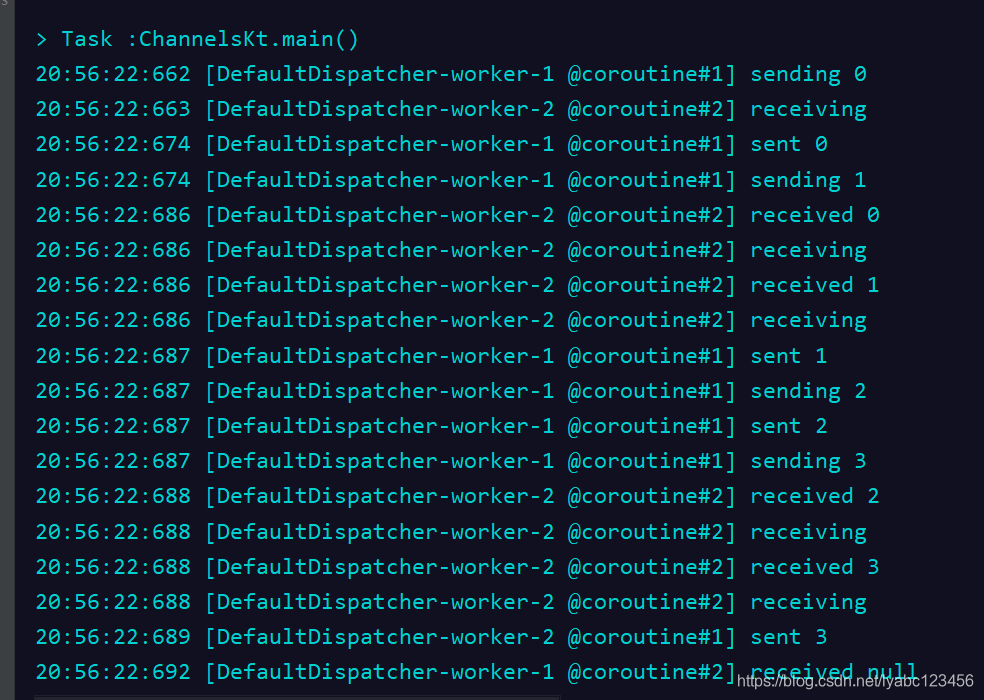

channel 接受数据的时候可以直接当成迭代器使用:
suspend fun iterateChannel() {
val channel = Channel<Int>(Channel.UNLIMITED)
val producer = GlobalScope.launch {
for (i in 0..3) {
log("sending", i)
channel.send(i)
log("sent", i)
}
channel.close()
}
val consumer = GlobalScope.launch {
for (i in channel) {
log("received: ", i)
}
}
producer.join()
consumer.join()
}

suspend fun producer() {
val receiveChannel = GlobalScope.produce(capacity = Channel.UNLIMITED) {
for (i in 0..3) {
log("sending", i)
send(i)
log("sent", i)
}
}
val consumer = GlobalScope.launch {
for (i in receiveChannel) {
log("received: ", i)
}
}
consumer.join()
}
suspend fun consumer() {
val sendChannel = GlobalScope.actor<Int>(capacity = Channel.UNLIMITED) {
for (i in this) {
log("received: ", i)
}
}
val producer = GlobalScope.launch {
for (i in 0..3) {
log("sending", i)
sendChannel.send(i)
log("sent", i)
}
}
producer.join()
}


suspend fun broadcast() {
//下面几种都可以创建一个 BroadcastChannel
//val broadcastChannel = BroadcastChannel<Int>(Channel.BUFFERED)
//val broadcastChannel = Channel<Int>(Channel.BUFFERED).broadcast()
val broadcastChannel = GlobalScope.broadcast {
for (i in 0..5) {
send(i)
}
}
//启动 5 个接受者,每个都能收到
List(5) { index ->
GlobalScope.launch {
val receiveChannel = broadcastChannel.openSubscription()
for (i in receiveChannel) {
log("[#i")
}
}
}.joinAll()
}
输出:
Task :ChannelsKt.main()
21:07:12:924 [DefaultDispatcher-worker-3 @coroutine#2] [#0] received: 0
21:07:12:924 [DefaultDispatcher-worker-5 @coroutine#6] [#4] received: 0
21:07:12:924 [DefaultDispatcher-worker-1 @coroutine#3] [#1] received: 0
21:07:12:925 [DefaultDispatcher-worker-4 @coroutine#5] [#3] received: 0
21:07:12:925 [DefaultDispatcher-worker-2 @coroutine#4] [#2] received: 0
21:07:12:944 [DefaultDispatcher-worker-1 @coroutine#3] [#1] received: 1
21:07:12:943 [DefaultDispatcher-worker-3 @coroutine#2] [#0] received: 1
21:07:12:943 [DefaultDispatcher-worker-5 @coroutine#6] [#4] received: 1
21:07:12:944 [DefaultDispatcher-worker-4 @coroutine#5] [#3] received: 1
21:07:12:945 [DefaultDispatcher-worker-2 @coroutine#4] [#2] received: 1
21:07:12:945 [DefaultDispatcher-worker-2 @coroutine#4] [#2] received: 2
21:07:12:945 [DefaultDispatcher-worker-8 @coroutine#3] [#1] received: 2
21:07:12:945 [DefaultDispatcher-worker-8 @coroutine#3] [#1] received: 3
21:07:12:945 [DefaultDispatcher-worker-7 @coroutine#4] [#2] received: 3
21:07:12:945 [DefaultDispatcher-worker-2 @coroutine#6] [#4] received: 2
21:07:12:946 [DefaultDispatcher-worker-2 @coroutine#6] [#4] received: 3
21:07:12:946 [DefaultDispatcher-worker-8 @coroutine#5] [#3] received: 2
21:07:12:946 [DefaultDispatcher-worker-8 @coroutine#5] [#3] received: 3
21:07:12:946 [DefaultDispatcher-worker-3 @coroutine#2] [#0] received: 2
21:07:12:946 [DefaultDispatcher-worker-3 @coroutine#2] [#0] received: 3
21:07:12:946 [DefaultDispatcher-worker-1 @coroutine#3] [#1] received: 4
21:07:12:946 [DefaultDispatcher-worker-3 @coroutine#2] [#0] received: 4
21:07:12:946 [DefaultDispatcher-worker-1 @coroutine#6] [#4] received: 4
21:07:12:947 [DefaultDispatcher-worker-6 @coroutine#5] [#3] received: 4
21:07:12:947 [DefaultDispatcher-worker-6 @coroutine#5] [#3] received: 5
21:07:12:947 [DefaultDispatcher-worker-2 @coroutine#3] [#1] received: 5
21:07:12:947 [DefaultDispatcher-worker-6 @coroutine#2] [#0] received: 5
21:07:12:947 [DefaultDispatcher-worker-2 @coroutine#6] [#4] received: 5
21:07:12:947 [DefaultDispatcher-worker-3 @coroutine#4] [#2] received: 4
21:07:12:947 [DefaultDispatcher-worker-3 @coroutine#4] [#2] received: 5


Select 的使用场景是多个协程异步执行时,获取最先结束的那个协程结果返回,比如加载图片时,可能从网络获取,也可能从本地获取,这两种可能同时异步执行,使用 Select 就会优先获取返回比较快的本地结果展示,然后我们再去获取网络最新的更新即可。

使用例子:
val localDir = File("localCache").also { it.mkdirs() }
val gson = Gson()
fun CoroutineScope.getUserFromApi(login: String) = async(Dispatchers.IO){
gitHubServiceApi.getUserSuspend(login)
}
fun CoroutineScope.getUserFromLocal(login:String) = async(Dispatchers.IO){
File(localDir, login).takeIf { it.exists() }?.readText()?.let { gson.fromJson(it, User::class.java) }
}
fun cacheUser(login: String, user: User){
File(localDir, login).writeText(gson.toJson(user))
}
data class Response<T>(val value: T, val isLocal: Boolean)
suspend fun main() {
val login = "test"
GlobalScope.launch {
val localDeferred = getUserFromLocal(login)
val remoteDeferred = getUserFromApi(login)
//val userResponse = Response(localDeferred.await(), true)
//select 选择优先返回的结果
val userResponse = select<Response<User?>> {
localDeferred.onAwait { Response(it, true) }
remoteDeferred.onAwait { Response(it, false) }
}
userResponse.value?.let { log(it) } //获取结果显示 输出
//如果是本地的结果,重新请求,并缓存本地
userResponse.isLocal.takeIf { it }?.let {
val userFromApi = remoteDeferred.await()
cacheUser(login, userFromApi)
log(userFromApi)
}
}.join()
}
如果有多个异步请求同时返回,select 会按顺序取第一个,想要随机的取可以使用 selectUnbiased

select 大括号中 onAwait 的写法等价于 await() 的写法,localDeferred.await(),还有很多操作join send等都是一样的前面加on

例子:使用 channel 和 select 实现统计代码行数
val KotlinFileFilter = { file: File -> file.isDirectory || file.name.endsWith(".kt") }
data class FileLines(val file: File, val lines: Int) {
override fun toString(): String {
return "lines"
}
}
suspend fun main() {
val result = lineCounter(File("."))
log(result)
}
suspend fun lineCounter(root: File): HashMap<File, Int> {
return Executors.newFixedThreadPool(Runtime.getRuntime().availableProcessors() + 1).asCoroutineDispatcher()
//使用 use 自动关闭资源
.use {
//withContext 是一个挂起函数 返回值是最后一行表达式的值
withContext(it){
val fileChannel = walkFile(root)
//定义 5 个同时读取
val fileLinesChannels = List(5){
fileLineCounter(fileChannel)
}
resultAggregator(fileLinesChannels)
}
}
}
//创建生产者返回 ReceiveChannel
fun CoroutineScope.walkFile(root: File): ReceiveChannel<File> {
return produce(capacity = Channel.BUFFERED) {
fileWalker(root)
}
}
//递归过滤 kotlin 文件并发送文件
suspend fun SendChannel<File>.fileWalker(file: File) {
if(file.isDirectory){
file.listFiles()?.filter(KotlinFileFilter)?.forEach { fileWalker(it) }
} else {
send(file)
}
}
//输入 File 返回 FileLines 对象
fun CoroutineScope.fileLineCounter(input: ReceiveChannel<File>): ReceiveChannel<FileLines> {
return produce(capacity = Channel.BUFFERED) {
for (file in input){
//统计行数
file.useLines {
send(FileLines(file, it.count())) //发送结果
}
}
}
}
suspend fun CoroutineScope.resultAggregator(channels: List<ReceiveChannel<FileLines>>): HashMap<File, Int> {
val map = HashMap<File, Int>()
channels.aggregate {
filteredChannels ->
//使用 select 返回最快统计的那一个
select<FileLines?> {
filteredChannels.forEach {
it.onReceiveOrNull {
log("received: $it")
it
}
}
} ?.let {
map[it.file] = it.lines
}
}
return map
}
//tailrec-递归优化 定义 List<ReceiveChannel<FileLines>>的扩展函数,过滤掉已完成的
tailrec suspend fun List<ReceiveChannel<FileLines>>.aggregate(block: suspend (List<ReceiveChannel<FileLines>>) -> Unit) {
block(this)//消费一次
//从当前 list 中过掉 isClosedForReceive=true 的 ReceiveChannel
filter { !it.isClosedForReceive }.takeIf { it.isNotEmpty() }?.aggregate(block)//递归
}

Sequence 中不能调用其他挂起函数,不能设置调度器,只能单线程中使用。而 Flow 可以支持:


Flow 中调用 delay 会把后面的代码切换到默认调度器上执行,也可以显示的指定调度器:


suspend fun flows(){
val intFlow = flow {
emit(1)
delay(100)
emit(2)
emit(3)
}
val dispatcher = Executors.newSingleThreadExecutor { Thread(it, "MyThread").also { it.isDaemon = true } }.asCoroutineDispatcher()
GlobalScope.launch(dispatcher) {
intFlow.flowOn(Dispatchers.IO)
.collect { log(it) }
}.join()
}

对比 RxJava 的线程切换方式很像,flowOn 传递的调度器指定 flow 里面的代码执行在哪个线程上,而 launch 传递的调度器指定 flow 执行完后 resume 恢复执行在哪个线程上。


flow-catch-onCompletion 和 java 的 try-catch-finally 基本类似,onCompletion 中的代码是一定会执行的,不同的是有异常发生的时候,会携带一个异常参数。
suspend fun exception(){
flow<Int> {
emit(1)
throw ArithmeticException("Div 0")
}.catch {t: Throwable ->
log("caught error: $t")
}.onCompletion { t: Throwable? ->
log("finally.")
}.flowOn(Dispatchers.IO)
.collect { log(it) }
// flow { // bad!!!
// try {
// emit(1)
// throw ArithmeticException("Div 0")
// } catch (t: Throwable){
// log("caught error: $t")
// } finally {
// log("finally.")
// }
// }
}
flow 的异常捕获使用 flow 自己的 api 处理就行,不需要内部再进行 try-catch.

Flow 没有提供单独的取消方法,要取消 Flow 只需要取消 flow.collect { } 所在的协程即可。



Flow 内部不能再去切换线程,如果需要这样做可以使用 channelFlow。

由于是流的概念 flow 也有背压的问题,也就是接受端来不及消费,发送端会累积大量的数据,感觉 kotlin 抄 RxJava 也抄了不少啊啊啊。。。背压解决办法,要么采用只保留最新 conflate,要么取消之前发送的值 collectLatest

suspend fun backPressure(){
flow {
emit(1)
delay(50)
emit(2)
}.collectLatest { value ->
println("Collecting $value")
delay(100) // Emulate work
println("$value collected")
}
}
上面的例子 collectLatest 当中 100 毫秒之后只能接受到 2,因为延时 100 的过程中发送 2 的时候会把 1 取消掉。












评论